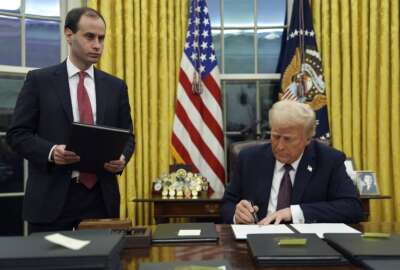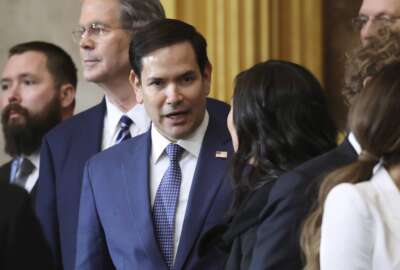NOAA has a grant program for local communities to deal with climate change
NOAA and ICF have teamed up with other organizations on a climate change resilience grant program and playbook for local communities.
States and many counties and municipalities are trying to become more resilient in the face of weather and climate events. Now the National Oceanic and Atmospheric Administration and ICF have teamed up with other partners, including the Climate Resilience Fund (CRF), EcoAdapt, Fernleaf, Geos Institute, and the Environment Equity and Justice Center at NRDC, on a climate change resilience grant program and, to use the modern parlance, playbook. The Federal Drive with Tom Temin found out how the partnership works from ICF senior consultant Adam Parris and NOAA program manager Ned Gardiner.
Interview transcript:
Tom Temin Ned, we’ll start with you. How does this work? What is NOAA exactly doing here? You’ve got $12.5 million for grants. What does NOAA bring to this? And we’ll get into what ICF is bringing to it.
Ned Gardiner NOAA has been investing in this community of practice who are working on climate adaptation on a national scale. And for the last seven years, preceding this grant initiative, we had collaborated with folks like Adam who are out there in the field, doing adaptation work in different towns around the country, and we coinvested in projects that would help everybody to do adaptation work. What we’re doing, the Climate Smart Communities Initiative, is coming up with a systematic way to support many communities doing this work and being able to compare their results and show a positive return on investment, especially focusing on underserved and historically underprivileged communities that are bearing the greatest brunt of the impacts of a changing climate,
Tom Temin And again, getting back to the number of $12.5 million, in federal grant terms, that’s not much. So what do you plan to do with the money? What will it buy? Let’s put it that way.
Ned Gardiner You’re right. We’re working on the kinds of investments that can spur longer term innovation and collaboration. So a major thrust of this work is building capacity at a local level, within governments and community-based organizations to learn from and use the kind of knowledge and experience that people like Adam bring to the table. So we will have small grants in the form of one year efforts in communities to bring climate adaptation experts into working with government officials, decision makers and community based organizations, so that they can learn about how to use climate information to design health systems, roads, all manner of programs and different societal services that are impacted by climate change. And the intention is that over a long period of time, they’d be then able to go after larger sums of money, enact complex projects and then build capacity long term in their own community. So it’s seed money, if you will, to have adaptation capacity at a local level.
Tom Temin And I said $12.5 million; it’s really $12.7 million, so you’ve got a couple more in there, under the wire. And Adam, talk about ICF and what it’s bringing to this. It sounds like you have a practice in helping these units, these governmental units or organizations, with understanding how they have to adapt.
Adam Parris That’s absolutely right. And we are essentially a support function, and in many cases across the country, in local, state or regional governments, they’re trying to grapple with these challenges of floods, heat, combined with the fact that they’ve got aging infrastructure and folks who need a leg up, and we often provide a support function by taking their input, combining that with analysis and putting it together in a plan. And in addition to what Ned said, this award that we’re getting to work with Cook County, Illinois will extend the efforts that we’re already doing. So the county had funding to help five municipalities, five towns within the county, build resilience plans and implement some of those actions. With the CSCI funding, we’re able to bring those five municipalities together, help them figure out a process to track what they’re doing and see is it working, or in what ways is it working, and how do they need to adjust, and is there one key ingredient for success that would help them really tackle the problems that they’re facing with storms that bring a lot more rain?
Tom Temin We’re speaking with Adam Parris. He’s senior consultant at ICF, and with Ned Gardiner, a program manager in the Climate Smart Communities Initiative at NOAA. And Ned, earlier, you said it’s not just governments that are available for these grants and this consulting from ICF, but also community organizations could that include, say, if a particular zone of a large city feels overlooked by what that giant city is doing because their neighborhood is lower, near the sea level, or whatever the case might be, that some community group could get this help where the city maybe is overlooking them.
Ned Gardiner Absolutely, the definition of a community really is open to interpretation, as you’re kind of implying. A community could be an entire county. It could be a city, a municipality, small town or a neighborhood. A neighborhood organization could identify that there are persistent problems for particular people that they’re concerned with serving during non-emergency times for community services, and by understanding the needs of communities and making those the impetus or decision making, we have a better opportunity to provide realistic, longer term support, because we’re essentially providing climate expertise as a bulwark to a bigger vision about how a community functions. And Tom, I want to go back to your first question about, what does NOAA bring to this? We’ve been investing in providing national scale tools for all the federal government, called the Climate Resilience Toolkit. It’s an outlet where people can go find case studies, tools, the reports, the fundamental research that underlies our nation’s understanding of the impacts of climate change in context. So we’ve been working at that problem since 2014 and so working with the climate smart communities initiative, which is really a coalition of many organizations, we’re working to systematize actually enacting and helping people do this work. And so Adam is a great champion and example of someone who’s able to bring that expertise to the ground.
Tom Temin And Adam, give us an example of what, say, a community, a small town or a neighborhood could do. They can’t do anything about climate change themselves. They could ban leaf blowers or plastic bags, that kind of thing. But if they’re low and they get flooded a lot, or if, for some reason, it’s a hot spot because there’s not enough trees, or you’re talking more about mitigation and resilience than actually dealing with the climate itself. Is that fair to say?
Adam Parris We’re talking about managing the impacts, trying to anticipate and avoid them, or to the extent that they encounter them, manage them and maybe even take advantage? So there are a whole host of things that folks can do. In the case of flooding, if you start at the building scale, people can take critical infrastructure, things like their HVAC system or their other critical equipment, and elevate it, put it on the roof, maybe especially in commercial buildings. And then if you move out to the neighborhood scale, you can think about ways to use nature to capture and absorb rainfall so that it doesn’t overwhelm the storm drain system all at once. And then you can think about ways to capture those larger scale features, things like detention ponds or bioswales, ways to route and store that water, and maybe even do that at the same time as you’re providing some green space that is both an amenity for the community when it’s not flooding, but also a feature that helps store floodwaters. So you’re looking for solutions that use nature as best as possible, that provide an amenity to the town when you’re not encountering severe storms or other climate impact, and that provide additional benefit beyond managing the impacts of climate.
Tom Temin And Ned, what are some of the deadlines, and how does this whole thing get underway? And what do people do to take advantage of it?
Ned Gardiner We’re operating the climate smart communities initiative with funding from the inflation Reduction Act, so we have a four year window to get this program up and running and demonstrate a return on investment for the United States. We certainly plan to show that through annual competitions, the primary recipient of this grant is the Climate Resilience Fund, and they source money from the federal government, but also philanthropy. And so with annual competitions, they’re combining these sources of funding to support people like Adam going out into communities and documenting that they’ve made progress “along the steps to resilience,” is the phrase we use to document, whether documenting and understanding forming a team, establishing a vision and mission, looking at exposure, vulnerability and risk to climate related hazards, then prioritizing, designing and implementing things that address that risk. So it’s through that systematic process that we can demonstrate the value to philanthropy and the federal government and really local government. Ultimately, if we can leverage local, municipal, county and even state resources to sustain this work over the long term, I think will have a very successful program.
Copyright © 2025 Federal News Network. All rights reserved. This website is not intended for users located within the European Economic Area.
Tom Temin is host of the Federal Drive and has been providing insight on federal technology and management issues for more than 30 years.
Follow @tteminWFED






